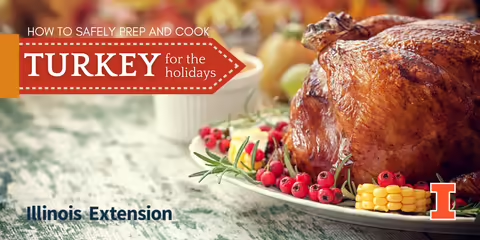The main centerpiece of a traditional Thanksgiving celebration may well be the turkey. The honor of carving is often reserved for a special family member. But before carving, the turkey must be cooked, and cooked safely.
Most stores sell turkeys frozen, leaving the task of thawing up to the customer. At Let's Talk Turkey—A Consumer Guide to Safely Roasting a Turkey, the United States Department of Agriculture (USDA) recommends thawing in the refrigerator and allowing
24 hours of thaw time for every 4 to 5 pounds of turkey. This makes planning ahead very important!
To thaw a frozen turkey, place turkey in a shallow container in the refrigerator. The container will catch any liquids that may drip from the packaging. When removing the turkey from its packaging, do not wash the turkey - or any poultry - before cooking. Washing poultry spreads bacteria around the kitchen and may make you, your family, or guests sick.
Remember to remove the giblet packages - the heart, liver, and gizzard - from the turkey’s cavity before cooking. If using giblets to make gravy, stuffing, or casseroles, check that these dishes reach at least 165°F, just like the turkey.
When cooking a turkey in the oven, set the temperature no lower than 325°F. The USDA estimates an 8-12 pound turkey will cook between 2 hours and 45 minutes and 3 hours. If your family wants to cook the turkey using a smoker, electric roaster, grill, deep fat fryer, pressure cooker, or slow cooker, visit the USDA’s Turkey: Alternate Routes to the Table website for instructions and food safety tips. If carving is not too important to your family, consider cutting the turkey into pieces before cooking. Or spatchcock the turkey by cutting out the backbone with kitchen shears and laying the turkey flat.
Like chicken, turkey needs to reach an internal temperature of 165°F. Check the turkey’s temperature by inserting a food thermometer at three spots: the innermost part of the thigh and wing and the thickest part of the breast.
Stuffing is a popular side dish served with turkey. For food safety reasons, USDA recommends cooking the stuffing separately from the turkey. If your family’s preference is to place the stuffing inside the turkey, pack it loosely to allow for proper heating and make sure the stuffing also reaches 165°F.
While it is tempting to leave turkey and side dishes out while visiting with family and friends, playing games, or watching football, set a timer to put leftovers in the refrigerator within 2 hours from when foods began sitting out at room temperature. Store all leftovers in shallow containers.
Use refrigerated leftovers within 3 to 4 days. Freeze any leftovers you do not plan to use within that time. When ready to eat leftover turkey, for recipes like turkey noodle soup, use a food thermometer to ensure the meat reaches 165°F when reheating.
For more information on cooking turkeys and other recipes for the holidays, visit Turkey for the Holidays from Illinois Extension.
SOURCE: Caitlin Mellendorf, MS, RD, Nutrition and Wellness Educator, University of Illinois Extension
SOURCE: Lisa Peterson, MS, Nutrition and Wellness Educator, University of Illinois Extension
ABOUT EXTENSION: Illinois Extension leads public outreach for University of Illinois by translating research into action plans that allow Illinois families, businesses, and community leaders to solve problems, make informed decisions, and adapt to changes and opportunities.
LINKED WEBSITES:
https://go.illinois.edu/USDASafeTurkeyPrep
https://web.extension.illinois.edu/turkey/breadstuffing.cfm
